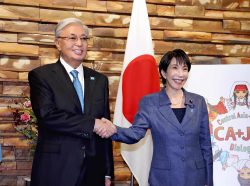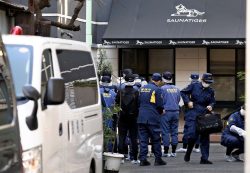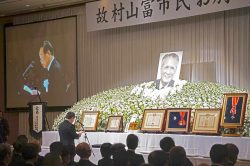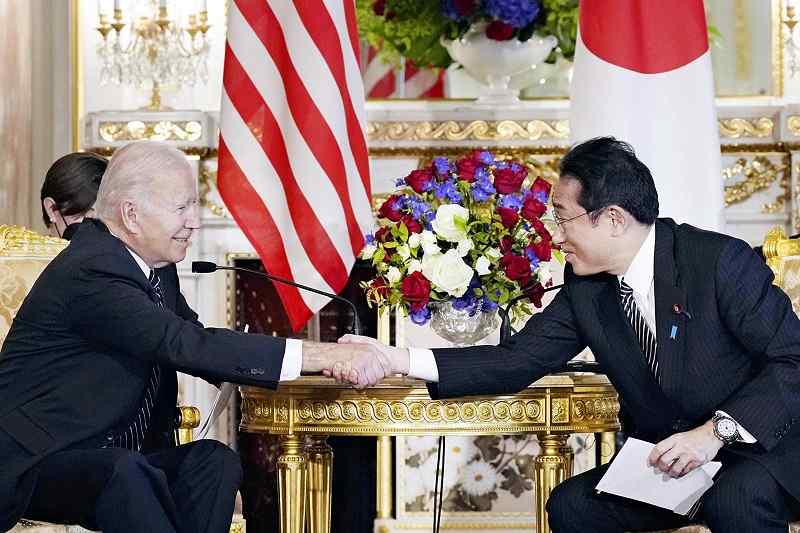
Prime Minister Fumio Kishida and U.S. President Joe Biden shake hands during their summit in Tokyo on Monday.
7:00 JST, May 25, 2022
The U.S.-led Indo-Pacific Economic Framework (IPEF) was launched Monday, with the pact positioned as an alternative to the Trans-Pacific Partnership free trade agreement as part of Washington’s efforts to counter China.
Out of consideration for U.S. public opinion, IPEF stops short of opening up markets through tariff reductions. Whether it will become an effective economic partnership remains to be seen.
In the opening remarks of Monday’s bilateral summit with Prime Minister Fumio Kishida, U.S. President Joe Biden said the purpose of IPEF is “to increase our cooperation with other nations in the region and to deliver concrete benefits for the people of the Indo-Pacific region.”
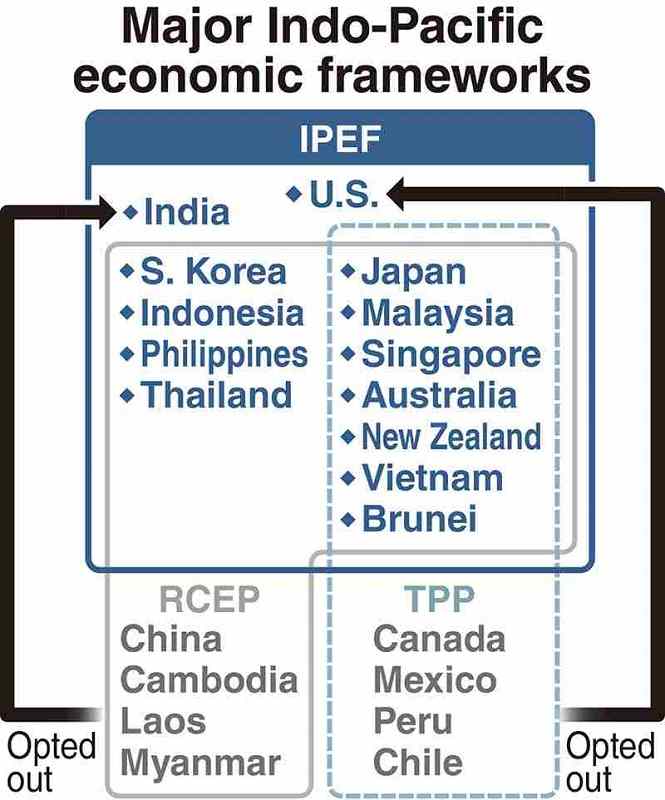
Biden first introduced the idea at the East Asia Summit last October amid a heightening sense of crisis in Washington over Beijing’s growing influence.
A month earlier, China, a member of the Regional Comprehensive Economic Partnership (RCEP) agreement, had applied to join the successor of the TPP, the Comprehensive and Progressive Agreement for Trans-Pacific Partnership (CPTPP), of which the United States is not a member.
The TPP was originally promoted by the administration of former U.S. President Barack Obama as a network to contain China, but the administration of his successor, Donald Trump, withdrew from the agreement on the grounds that it threatened industries and jobs in the United States.
The Biden administration, which has adopted a protectionist stance out of consideration for the working class, came up with IPEF in a bid to fill the void for U.S. economic partnership in Asia. However, the framework does not include a reduction or elimination of tariffs, as deep-rooted concerns remain in the United States about the impact of such measures on domestic industries and employment.
In the months leading up to its launch, Japan mediated between the United States and the members of the Association of Southeast Asian Nations (ASEAN). According to diplomatic sources, Tokyo advised Washington to tone down the anti-China posturing to avoid making ASEAN nations with strong economic ties with Beijing pick sides.
A framework that does not deal with tariffs has few advantages for economies that want to sell more products in the United States, so it was thought that it would only attract a small number of countries.
However, Washington promoted fields in which there is high interest in emerging Asian countries, such as strengthening semiconductor supply networks and infrastructure development, and lowered the hurdle for involvement in the framework by inviting participation in individual fields.
After persistent efforts, seven of the 10 ASEAN countries decided to join.
“IPEF will not be able to fulfill its purpose unless it obtains active cooperation in Southeast Asia by demonstrating real benefits,” said a source linked to U.S. trade negotiations.
The actions of the ASEAN countries will likely be a focus in future negotiations.
Japan aims to strengthen the economic partnership with the United States through active involvement in the framework and attract Washington back to the CPTPP.
At a joint press conference with Biden on Monday, Kishida said, “Japan hopes to see the United States return to the [CP]TPP from a strategic perspective.”
"Business" POPULAR ARTICLE
-

Keidanren Chairman Yoshinobu Tsutsui Visits Kashiwazaki-Kariwa Nuclear Power Plant; Inspects New Emergency Safety System
-

Imports of Rare Earths from China Facing Delays, May Be Caused by Deterioration of Japan-China Relations
-

University of Tokyo Professor Discusses Japanese Economic Security in Interview Ahead of Forum
-

Tokyo Economic Security Forum to Hold Inaugural Meeting Amid Tense Global Environment
-

Japan Pulls out of Vietnam Nuclear Project, Complicating Hanoi’s Power Plans
JN ACCESS RANKING
-

Keidanren Chairman Yoshinobu Tsutsui Visits Kashiwazaki-Kariwa Nuclear Power Plant; Inspects New Emergency Safety System
-

Imports of Rare Earths from China Facing Delays, May Be Caused by Deterioration of Japan-China Relations
-

University of Tokyo Professor Discusses Japanese Economic Security in Interview Ahead of Forum
-

Tokyo Economic Security Forum to Hold Inaugural Meeting Amid Tense Global Environment
-

Japan Pulls out of Vietnam Nuclear Project, Complicating Hanoi’s Power Plans




